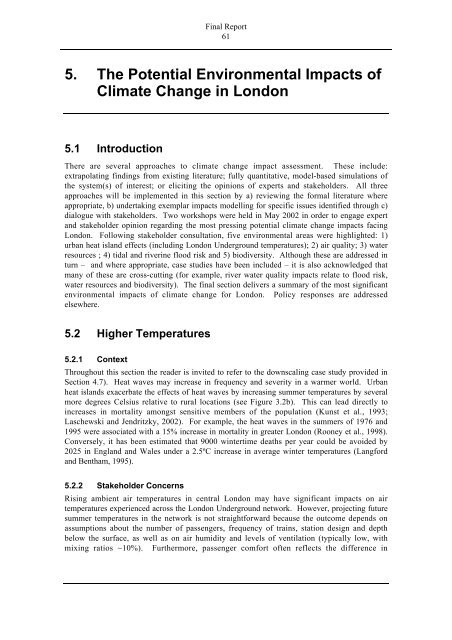London scoping - ukcip
London scoping - ukcip
London scoping - ukcip
Create successful ePaper yourself
Turn your PDF publications into a flip-book with our unique Google optimized e-Paper software.
Final Report<br />
61<br />
5. The Potential Environmental Impacts of<br />
Climate Change in <strong>London</strong><br />
5.1 Introduction<br />
There are several approaches to climate change impact assessment. These include:<br />
extrapolating findings from existing literature; fully quantitative, model-based simulations of<br />
the system(s) of interest; or eliciting the opinions of experts and stakeholders. All three<br />
approaches will be implemented in this section by a) reviewing the formal literature where<br />
appropriate, b) undertaking exemplar impacts modelling for specific issues identified through c)<br />
dialogue with stakeholders. Two workshops were held in May 2002 in order to engage expert<br />
and stakeholder opinion regarding the most pressing potential climate change impacts facing<br />
<strong>London</strong>. Following stakeholder consultation, five environmental areas were highlighted: 1)<br />
urban heat island effects (including <strong>London</strong> Underground temperatures); 2) air quality; 3) water<br />
resources ; 4) tidal and riverine flood risk and 5) biodiversity. Although these are addressed in<br />
turn – and where appropriate, case studies have been included – it is also acknowledged that<br />
many of these are cross-cutting (for example, river water quality impacts relate to flood risk,<br />
water resources and biodiversity). The final section delivers a summary of the most significant<br />
environmental impacts of climate change for <strong>London</strong>. Policy responses are addressed<br />
elsewhere.<br />
5.2 Higher Temperatures<br />
5.2.1 Context<br />
Throughout this section the reader is invited to refer to the downscaling case study provided in<br />
Section 4.7). Heat waves may increase in frequency and severity in a warmer world. Urban<br />
heat islands exacerbate the effects of heat waves by increasing summer temperatures by several<br />
more degrees Celsius relative to rural locations (see Figure 3.2b). This can lead directly to<br />
increases in mortality amongst sensitive members of the population (Kunst et al., 1993;<br />
Laschewski and Jendritzky, 2002). For example, the heat waves in the summers of 1976 and<br />
1995 were associated with a 15% increase in mortality in greater <strong>London</strong> (Rooney et al., 1998).<br />
Conversely, it has been estimated that 9000 wintertime deaths per year could be avoided by<br />
2025 in England and Wales under a 2.5ºC increase in average winter temperatures (Langford<br />
and Bentham, 1995).<br />
5.2.2 Stakeholder Concerns<br />
Rising ambient air temperatures in central <strong>London</strong> may have significant impacts on air<br />
temperatures experienced across the <strong>London</strong> Underground network. However, projecting future<br />
summer temperatures in the network is not straightforward because the outcome depends on<br />
assumptions about the number of passengers, frequency of trains, station design and depth<br />
below the surface, as well as on air humidity and levels of ventilation (typically low, with<br />
mixing ratios ~10%). Furthermore, passenger comfort often reflects the difference in

















